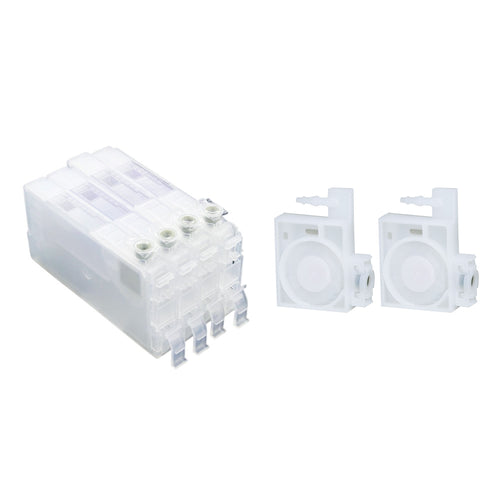What is a Heat Press?
A heat press machine is a device engineered to transfer a design or graphic onto various substrates—such as t-shirts, and hats,—using a combination of heat, pressure, and time. Unlike traditional printing methods that often involve multiple steps, a heat press simplifies the process by ensuring the transfer is permanent, vibrant, and durable.
How Does a Heat Press Work?
At its core, a heat press comprises two main parts: the upper heated platen and the lower platen (or bed). When activated, the heated upper platen is pressed down onto the substrate (which has the transfer material placed on it) with a specific amount of pressure. The combination of heat and pressure for a preset time causes the adhesive on the transfer material to bond with the fabric or item below. The result is a design fully integrated into the substrate and built to last through multiple washes or uses.
The key to success with a heat press is precision. Modern machines offer digital temperature, time, and pressure controls to ensure consistency from one transfer to the next. This is especially important for professional results where uniformity is crucial.
Types of Heat Presses
Several types of heat presses are available, each designed for different tasks:
Clamshell Heat Press: This type opens and closes like a clam, making it compact and easy to use in smaller spaces. It's great for beginners and those working on smaller items.

Swing-Away Heat Press: The top plate swings away from the bottom plate, allowing for easier placement of items and reducing the risk of burns. This type is ideal for thicker materials or more oversized items.

Draw Heat Press: The bottom plate pulls out like a drawer, giving you more space to position your items without being directly under the heating element.

Handheld Heat Press:
This is a lightweight, portable device you can operate by hand. It's perfect for small projects or when you're on the go.

16×24 Dual-Station Heat Press: This dual-station heat press has two separate workstations. It can process two items at the same time.

For more details, You can refer to this blog Must-read guide: Heat Press Machines for DTF Printer on how to choose your heat press machine
Benefits of Using a Heat Press
Versatility and Creativity
One of the greatest advantages of using a heat press machine is its versatility. Whether you’re a small business owner, a hobbyist, or a professional in the custom printing industry, a heat press can be used on a wide range of products:
Apparel: Transfer designs onto t-shirts, hoodies, and bags.
Accessories: Customize hats, scarves, and even shoes.
Home Goods: Personalize items such as cushions, towels, and even wall art.
Because a heat press can work with different transfer methods—like heat transfer vinyl (HTV), sublimation, plastisol, or even rhinestone applications—it opens up a world of creative possibilities without the need for multiple machines.
Cost-Effectiveness
For many, the heat press machine represents a cost-effective solution to produce high-quality, professional-grade transfers. Once you invest in a good machine, the per-unit cost of transferring designs is often lower than alternative methods like screen printing, especially for small to medium runs. The simplicity of the process also means that you don’t need extensive training to achieve excellent results.
Speed and Efficiency
When compared to traditional printing methods, heat pressing is remarkably fast. With features such as quick heat-up times, auto-open functions, and digital preset controls, you can increase your throughput without sacrificing quality. For businesses dealing with high volumes, this efficiency can translate into significant time and cost savings.
FAQs: What You Need to Know
As a potential buyer, you may have several questions about heat press machines. Here are some frequently asked questions from customers like you:
Q: How long does a heat press machine last?
A: With proper maintenance and care, a high-quality heat press machine can last over a decade. The durability often depends on usage frequency, build quality, and whether the machine is used in a professional or hobbyist setting.
Q: What size heat press should I buy?
A: The ideal size depends on your projects. For small items like baby onesies or hats, a 9” x 12” press may suffice. For full-sized t-shirts and larger designs, a machine with a 15” x 15” or 16” x 20” platen is recommended. Consider your current needs and potential future projects when choosing a size.
Q: Can I use a heat press for materials other than fabric?
A: Yes! Heat presses are incredibly versatile. They can be used for vinyl transfers and sublimation printing, The key is to choose the right type of heat press or attachments for the specific substrate.
Q: What maintenance does a heat press machine require?
A: Regular cleaning, checking for loose parts, and ensuring even heating are essential. Follow the manufacturer’s instructions for maintenance, and perform routine inspections to keep your machine in top condition.
Q: Are digital controls really necessary?
A: Digital controls provide precision, consistency, and ease of use. They are especially important if you plan to produce high-quality, repeatable results. While manual models are available and may be less expensive, the accuracy of digital models often makes them a better long-term investment.
In the field of direct to film (DTF) printing, besides the heat press, there is another machine that plays a crucial role: the DTF curing oven.
What is a DTF Curing Oven?
A DTF curing oven is a specialized machine designed to cure the adhesive powder and inks used in DTF printing. In the DTF process, a printer first deposits a design onto a special film using DTF inks. Next, an adhesive powder is applied over the printed design. The film is then passed through a curing oven where heat and controlled airflow activate the adhesive, ensuring it bonds firmly to the substrate during the transfer process.
Key Features to Look For in a DTF Curing Oven
When selecting a DTF curing oven, it’s essential to consider a range of features that will affect your production quality and efficiency.
1. Temperature Control and Uniformity
Precise Digital Controls:
Look for ovens that offer digital temperature controls, allowing you to set the exact temperature required for your specific adhesive and ink formulation.
Uniform Heating:
An ideal curing oven should provide even heat distribution across the entire chamber. Uneven heating can result in inconsistent curing, leading to transfers that are prone to failure.
2. Curing Time and Throughput
Digital Timer:
A built-in digital timer allows you to set precise curing times. This feature is critical for ensuring that every transfer is cured for the optimal duration.
Fast Heating Elements:
High-quality heating elements that reach the set temperature quickly can significantly increase your production speed and reduce downtime between batches.
Introducing InkSonic DTF A3 Curing Oven
Specifications
Application : This oven is suitable for curing A3 offset heat transfer film, ink, and adhesive powder.
Maximum Curing Size : 32 x 43 cm / 12.6" x 16.9"
Rated Voltage : 220V
Rated Current : 8A
Rated Power : 1.8KW
Machine Dimensions : 630mm x 410mm x 210mm / 24.8" x 16.1" x 8.3"
Weight : 10KG / 22 lbs
Highlights of the A3 Curing Oven :
Automatic Temperature and Time Settings with Alarm : This A3 curing oven offers convenient temperature and time adjustment features. A built-in buzzer will sound when the preset time is reached.
High-Quality Materials : The oven is made with high-temperature-resistant ceramic coating to ensure flame retardancy, fire resistance, and durability under high heat.
Fast Heating Speed : Our curing oven uses carbon fiber quartz heating tubes, known for their rapid heating, high thermal conversion efficiency, long lifespan, and environmental friendliness. The adjustable exhaust port helps increase heating speed and save valuable time.
Safe and Convenient Design : The oven is supported by 365 hydraulic rods and features a dual-handle design, making it easy to open and close both the oven lid and drawer.
Maintenance tasks on the DTF curing oven
Key maintenance tasks include:
- Cleaning the interior surfaces and heating elements after each use.
- Inspecting and cleaning the ventilation system and fans.
- Checking seals, gaskets, and digital controls periodically.
- Performing routine calibration if necessary. Following a regular maintenance schedule as outlined in your manufacturer’s manual is essential for long-term performance.
FAQs
Q: Can I use a regular oven for DTF curing?
A: No—household ovens lack precise temperature control and may damage transfers.
Q: How long does DTF curing take?
A: 2–5 minutes depending on fabric thickness and adhesive type.
Q: What safety certifications should a DTF oven have?
A: Look for UL (US) or CE (EU) marks for electrical safety.
How Heat Presses and DTF Curing Ovens Work Together?
While the curing oven and heat press machine serve different purposes, their functions are interconnected in the DTF printing process.
Sequential Process: The curing oven prepares the design by melting the adhesive powder, making it ready for transfer. The heat press then completes the process by bonding the design to the fabric.
Quality Assurance: Proper curing ensures that the adhesive is in the ideal state for transfer, while the heat press solidifies the bond, resulting in a durable and high-quality print.
Efficiency: Using both machines in tandem streamlines the workflow, allowing for faster production times and consistent result
Conclusion
In the DTF printing process, both the curing oven and heat press machine are indispensable. The curing oven ensures that the adhesive powder is properly melted and ready for transfer, while the heat press machine finalizes the process by bonding the design to the fabric. Understanding the functions and interplay of these machines is crucial for producing high-quality, durable prints. By selecting the right equipment and using them effectively, businesses can optimize their DTF printing operations, ensuring consistent results and customer satisfaction.


































